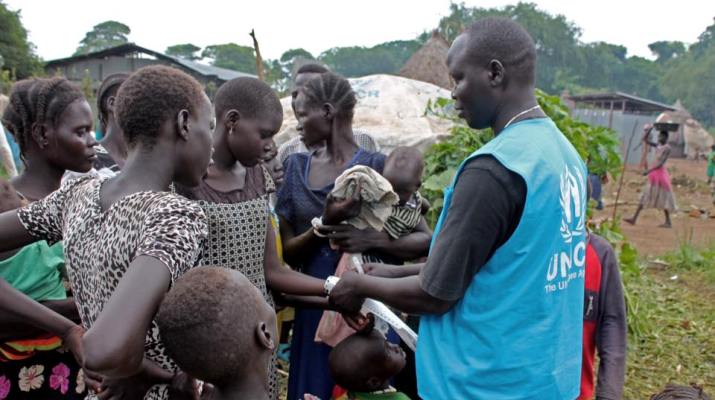UNHCR opens new camp for S. Sudanese refugees in Ethiopia

By Tesfa-Alem Tekle
November 18, 2016 (ADDIS ABABA) – The United Nations Higher Commissioner for refugees (UNHCR) on Friday said that it has opened a new camp as it records high influx of South Sudanese refugees flocking in to Ethiopia.
Nearly 40,000 South Sudanese refugees have arrived in Ethiopia’s Gambella region since early September.
Most of the new arrivals have been registered and relocated to Jewi, Kule, Tierkidi and Nguenyyiel refugee camps, whilst 806 registered persons await relocation.
According to the UN refugee agency, currently on average, some 547 south Sudanese refugees arrive in Ethiopia on a daily basis.
64% of the total registered new arrivals are children, including 8,392 unaccompanied and separated children.
“This increasing trend of underage asylum-seekers from South Sudan adds to the already young refugee population in Gambella” UNHCR said.
The new arrivals, most originate from the Upper Nile State (94.2%) and Jonglie State (5.6%).
Since September, the operation in Ethiopia has experienced a fresh influx of refugees from South Sudan fleeing renewed violence and food shortages in their home country.
To shelter the new arrivals the UNHCR along with its main government counterpart, the Administration for Refugee and Returnees Affairs (ARRA) have built a new Camp in Gambela region which borders South Sudan.
Some 6,200 newly South Sudanese refugees who arrived recently have been relocated to the new camp, Nguenyyiel which is not far from the other camps.
As numbers of South Sudan refugees rises the UNHCR has requested USD 113.8 million for the South Sudan Situation in Ethiopia.
Currently Ethiopia hosts 324,075 South Sudanese refugees and asylum-seekers.
The horn of Africa’s country provides protection to refugees from some 20 countries, with the majority originating from South Sudan, Somalia, Eritrea and Sudan.
South Sudanese, Eritreans, Yemenis and Somalis originating from South and Central Somalia are granted automatic refugee status.
While to all other, individual refugee status determination is undertaken by the Government’s Eligibility Committee, on which UNHCR sits as an observer.
The Government maintains the policy requiring refugees to reside in refugee camps.
It however allows certain refugees to reside in the urban areas, primarily in the capital Addis Ababa.
They include refugees in need of special medical attention unavailable in camps; refugees with serious protection concerns or inability to stay in camps for humanitarian reasons.
Currently over 18,000 Eritrean refugees reside in Addis Ababa enrolled under the Out-of-Camp Policy (OCP).
Meanwhile the UN refugee agency said it will roll out the Education Management Information System (EMIS) before the end of the year,
The EMIS is intended to modernize the collection, reporting and usage of education-related data.
In preparation for that, UNHCR and ARRA organized familiarization trainings for all pertinent personnel working in refugee education across all refugee camps in Ethiopia. Education managers, school directors, programme officers and education data managers were some of the participants of the training.
The EMIS is a critical education management tool approved by UNESCO.
UNHCR, UNICEF SIGN MoU
UNHCR and UNICEF today signed a Letter of Understanding (LoU) and a joint plan of action to further strengthen their partnership in responding to the needs of refugees and host communities in Ethiopia.
The representatives of the two agencies to Ethiopia – Ms Clementine Nkweta-Salami (UNHCR) and Ms Gillian Mellsop (UNICEF) signed the agreement which outlines key areas of collaboration in child protection, education, health and nutrition, as well as water, sanitation and hygiene (WASH).
Under the present agreement, which is due to end in August 2020, the two agencies agreed to work together in accelerating their joint refugee response in terms of technical assistance, visibility, advocacy resource mobilization and supply management. In addition, the collaboration will have a strong focus on identifying risks and ensuring that contingency planning and preparedness measures are in place.
“UNICEF and UNHCR have a long history of effective and demonstrated collaboration in humanitarian action which has greatly improved the lives of refugees over the years. This agreement will further cement our partnership and help us to advance our respective mandates in Ethiopia,” said Ms Nkweta-Salami.
In UNHCR’s case, this means protecting, assisting and finding durable solutions to the plight of refugees and other persons of concern. For UNICEF, it allows for greater advocacy for vulnerable children by making sure that programmes and policies in response to the refugee crisis put the rights and needs of children first.
“The decision to have this agreement with UNHCR stems from our wish to formalize the complementarity of our work and ensure that we are jointly delivering results for children. Together, we will intensify our efforts to address the issues of refugees and host communities who need our protection and support,” said Ms Gillian Mellsop.
(ST)
